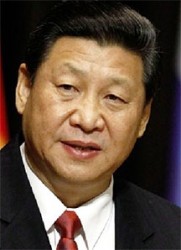BEIJING, (Reuters) – The Silk Road, an obscure Kazakh-inspired security forum and a $50 billion Asian infrastructure bank are just some of the disparate elements in an evolving Chinese strategy to try to counter Washington’s “pivot” to the region.
While Chinese leaders have not given the government’s growing list of initiatives a label or said they had an overall purpose, Chinese experts and diplomats said Beijing appeared set on shaping Asia’s security and financial architecture more to its liking.
“China is trying to work out its own counterbalance strategy,” said Sun Zhe, director of the Centre for U.S.-China Relations at Beijing’s Tsinghua University and who has advised China’s government on its foreign policy.
Added one Beijing-based Western diplomat who follows China’s international relations: “This is all clearly aimed at the United States.”

President Barack Obama’s pivot – as the White House initially dubbed it – represented a strategy to refocus on Asia’s dynamic economies as the United States disentangled itself from costly wars in Iraq and Afghanistan.
China sees the pivot as an attempt to contain its growing influence, especially given the United States is strengthening its ties with Asian security allies such as Japan and the Philippines, which have bitter territorial disputes with Beijing in the region’s waters. Washington denies this.
One key part of China’s diplomatic outreach has been to breathe life into the little-known Con- ference on Interaction and Confidence Building Measures in Asia, or CICA, which has languished since Kazakhstan proposed it in 1992 to promote peace and security.
CICA comprises two dozen mostly Asian nations, as well as Russia and some Middle Eastern countries. The United States, Japan and the Philippines are not members.
China took over chairmanship of CICA at a summit in Shanghai in May for three years. There, President Xi Jinping spoke about a new “Asian security concept”, saying China would explore the formulation of a code of conduct for regional security and an Asian security partnership programme.
While Xi gave few details and made no direct mention of disputes such as in the South China Sea, he warned Asian nations about strengthening military alliances to counter China, an oblique reference to the U.S. pivot.
“Asian problems must be resolved by Asian people, and Asian security must be protected by Asian people,” Xi said.
A RIVAL BANK?
Another Chinese initiative is the $50 billion Asian Infrastructure Investment Bank, which Xi first proposed in October during a visit to Southeast Asia.
Finance Minister Lou Jiwei said this week Beijing would likely have a 50 percent stake in the bank, which diplomats see as a possible rival to the World Bank and the Asian Development Bank, though China says its role is a complementary one, not competitive.
Washington and Tokyo have the biggest voting rights in both the decades-old institutions.
China sees the infrastructure bank as a way to spread the message of its benign intentions in Asia, where developing countries such as the Philippines and Vietnam accuse Beijing of being the aggressor over territorial claims.
“China upholds a basic guiding principle in regional diplomacy – being friends and partners with our neighbours,” Lou said.
On top of that, China has dangled financial and trade incentives to Central Asia, backing efforts to resurrect the old Silk Road that once carried treasures between China and the Mediterranean.
China is also pushing ahead with various trade pacts in the region, but is not part of negotiations for the Trans-Pacific Partnership (TPP), a 12-nation bloc whose two biggest economies are the United States and Japan.
Not everyone is convinced China’s initiatives will amount to much.
“Some of those things are more about the optics of these issues rather than the realities of a Chinese-led order,” said Matthew Goodman, senior adviser for Asian Economics at the Center for Security and International Studies in Washington.
WASHINGTON WATCHING
China’s foreign policy since the country began economic reforms three decades ago has traditionally followed the maxim of late paramount leader Deng Xiaoping of “hiding ones’ strength and biding ones’ time”, or keeping a low profile.
Foreign Minister Wang Yi earlier this year flagged China’s more assertive regional foreign policy at his annual press conference and in a newspaper article.
“We must accept the role of a responsible major country in international affairs,” Wang wrote. Asked this week whether China was carrying out its own pivot, Foreign Ministry spokesman Hong Lei said China was pursing a policy of good neighbourliness.
A senior Obama administration official said Washington was paying close attention to Xi’s approach to Asia.
“We noted his statement at the CICA conference about Asia for Asians, the growing criticism of U.S. alliances and the Asian infrastructure bank,” said the official, who spoke on condition of anonymity.
“It’s raising serious questions about whether the U.S. vision and the Chinese vision are fully compatible.”
A second senior U.S. official said Washington had not been assured that the infrastructure bank would adopt the high governance and other standards of institutions such as the World Bank and the ADB. He said the administration did not see how such an entity would “add value” for the region and that Washington would be making this point to Asian allies.
While they were not members, the United States and Japan were welcome to join the bank, Lou said. Top Chinese and U.S. officials will get the chance to discuss the bank and many other issues during annual talks in Beijing on July 9-10, a meeting known as the Strategic and Economic Dialogue.
FORGOTTEN ANNIVERSARIES
At the start of the CICA summit, China turned on the pomp, with live television showing Red Flag limousines delivering leaders one by one to a Shanghai conference centre where they walked down a red carpet to shake hands with Xi.









